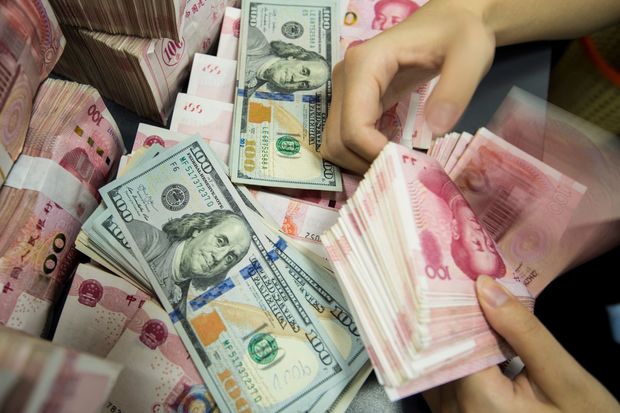

| 送交者: 祖母绿[★品衔R5★] 于 2020-01-13 19:39 已读 831 次 | 祖母绿的个人频道 |
U.S. Drops China’s Currency Manipulator Label Ahead of Trade DealMove comes two days before planned signing of a trade deal
6park.com 6park.com6park.com
The U.S. named China as a currency manipulator last August amid trade tensions between the nations. PHOTO: AGENCE FRANCE-PRESSE/GETTY IMAGES 6park.com
Joshua Zumbrun and 6park.com
WASHINGTON—The U.S. Treasury Department dropped its designation of China as a currency manipulator just two days before negotiators from Beijing and Washington are set to sign the first phase of the trade deal between the two countries.“China has made enforceable commitments to refrain from competitive devaluation, while promoting transparency and accountability,” Treasury Secretary Steven Mnuchin said in a statement Monday. 6park.com
6park.com
Yuan to DollarThe Chinese yuan crossed the 7-to-1 thresholdin August but recently has returned to about6.9 yuan per U.S. dollar.Yuan per dollarSource: Tullett PrebonNote: A higher yuan-to-dollar ratio indicates a weakerChinese currency. 6park.com6park.com
April ’19JulyOct.Jan. ’206.66.76.86.97.07.17.27.3 6park.com
Mr. Mnuchin’s statement accompanied the Treasury’s foreign-exchange report, which addresses the currency practices and macroeconomic policies of major U.S. trading partners. The report, typically released twice a year, is the Treasury’s primary vehicle for officially designating countries as currency manipulators. 6park.com
The report said the trade agreement’s chapter on Chinese currency practices addresses many of the concerns raised when the U.S. applied the manipulator designation in August. As part of the agreement, China will commit not to depress its exchange rate and will make additional disclosures about its foreign-exchange practices. The Treasury also noted that the Chinese currency had strengthened in recent months, a development that helps address U.S. concerns that the yuan is too weak.
The currency component has been a focus of Mr. Mnuchin in talks with China, and the administration has said it was one of the trade deal’s most significant parts.No new countries were slapped with the designation on Monday.
U.S. lawmakers, economists and industry representatives have long accused China of undervaluing its currency to make its exports more competitive, with some saying U.S. jobs were lost as a result. Even so, the concern had faded in recent years because Beijing wasn’t highly active in its currency markets. The Treasury Department refrained from branding China a manipulator until August, the first time it did so since 1994.
The designation, which came amid rising trade tensions between the world’s two largest economies, had little practical impact. By law, the action triggers negotiations that could eventually lead to the imposition of tariffs. But the U.S. was already negotiating with China over trade and had already followed the legal steps to impose tariffs on all Chinese imports.The law governing currency manipulation also directs the Treasury Department to ask the International Monetary Fund for assistance addressing currency manipulation. IMF research, however, didn’t support the conclusion that China had manipulated its currency. 6park.com
6park.com
Fred Bergsten, who was a top Treasury official in the Carter administration, said the designation was largely symbolic and was therefore ineffective as a pressure tactic in negotiations with China.
“It was such an obvious misstatement of reality that I think it did not create any pressure,” said Mr. Bergsten, who is now director of the Peterson Institute for International Economics.
The U.S. move on the decision was reported earlier Monday by Fox Business Network.
The Treasury Department uses three criteria to assess whether a country manipulates its exchange rate: the extent of active intervention in currency markets; the size of trade surpluses with the U.S.; and the size of the country’s current-account surplus, a broader measure of trade that includes investment income and other financial flows.
China’s overall current-account surplus is small because, despite a large trade surplus with the U.S., it has small surpluses, or even deficits, with many other countries. And China’s trade surplus with the U.S. has been dwindling as import duties damped purchases from China.
In the 12 months through December 2018, China’s surplus on trade in goods with the U.S. came to about $420 billion. As of November 2019, the 12-month surplus had fallen to about $360 billion.
Although the U.S. removed China’s “manipulator” label, it put the country back on a formal monitoring list reserved for countries that “merit close attention to their currency practices and macroeconomic policies.”
In Monday’s report, the Treasury added Switzerland to the watch list. Switzerland has a large and rising trade surplus with the U.S. and has intervened repeatedly in its foreign-exchange markets in recent years, though not at a large enough scale to trigger the “manipulator” label.
The Treasury said Switzerland should use fiscal policy to support its domestic economy and publish data about its currency interventions on a “higher-frequency basis.”
Eight other countries—Germany, South Korea, Japan, Italy, Ireland, Malaysia, Singapore and Vietnam—remained on the watch list, having been placed there in previous reports.
The U.S. has only ever labeled three countries as currency manipulators. It previously labeled China a manipulator from 1992 to 1994. Before that it had also hit Japan and Taiwan with the label in the late 1980s. 6park.com

